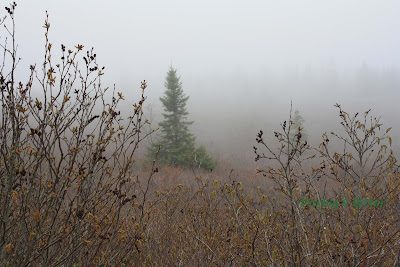Saturday, April 21, 2012
Spindly Black Spruce
Species name: Picea mariana (formerly Picea nigra)
Common name: Black spruce
Location: Nova Scotia
I took this photo in Kejimkujik National Park on the bog boardwalk leading out to the beach. It was a pretty typical maritime spring day: cool in the morning, warming up quickly and becoming incredibly foggy then the fog burning off by the mid-afternoon. This was one of those rare moments where you could see more than 10 feet in front of your face as a fog cloud was blown out of the way.
Black spruce is a typical plant of the boreal forest in Canada and Alaska. It's a native evergreen tree with a very typical shape: somewhat bushy at the bottom, becoming much narrower and more spindly towards the top. One of the most impressive characteristics of this plant towards the northern part of its range is that its a great indicator of predominant wind direction. Black spruce grows very slowly, and slower still when the wind is pushing against the tips of branches. The "wind side" of the tree has much shorter branches compared to the "sheltered side".
Black spruce is one of the many boreal species that require fire in order for their seeds to germinate in great numbers, and so for that reason this species is especially successful at recolonizing the boreal forest after a fire. Since forest fires are relatively common in this forest zone, stands of boreal forest that are dominated by black spruce are often trees of the same age (as opposed to typical successional forests where there are old and young trees of the same species in the same location). Within the boreal zone, it's an incredibly common tree and is at no risk of becoming a threatened or endangered speices.
Black spruce trees grow slowly and never attain a very large circumference despite the tree's age. For this reason they are not valuable lumber trees in the construction business. They are, however, a major source of pulp for the paper industry in Canada. As cultural importance, the black spruce is the provincial tree of Newfoundland and Labrador in Canada.
Subscribe to:
Post Comments (Atom)


I always wondered recolonization after a forest fire. I am NOW a bit more educated. Thank You
ReplyDeleteSome species require fire in order for their seeds to actually open, which doesn't seem too logical at first glance. The giant redwoods and giant sequoias are that way, which is logical at least for them. Forest fires are so common in redwood forests due to lightning strikes that any species that requires fire to reproduce has an advantage when it comes to recolonization after a disaster. Unfortunately, with methods of fire control (i.e. don't let fire happen) in National Parks in the US the populations of redwoods are really suffering and other, significantly more invasive, non-native species are taking over.
ReplyDelete